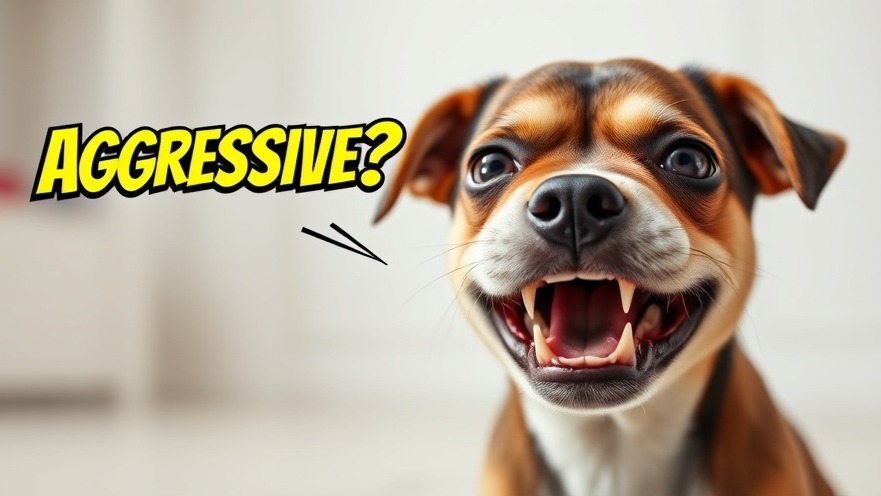
Understanding Dog Aggression: The Real Reasons Behind the Labels
When we think of aggression in dogs, the image of a snarling, biting creature often comes to mind. But what if I told you that the truth behind aggression is often rooted in fear or misunderstanding rather than malice? Many dog owners find themselves confused or scared when they see sudden changes in their pet's behavior, labeling their once-friendly companions as 'aggressive.' However, recognizing the underlying causes of this behavior is crucial.
Most commonly, aggression manifests not through outright biting, but through a series of subtle cues that dogs use to communicate. A growl, a stiff posture, or even food guarding can indicate that a dog feels threatened or uncomfortable. As a devoted dog owner, it's essential to look beyond the labels and understand that these displays are their attempts to express unhappiness or distress.
Common Signs of Aggression: What to Watch For
Aggression can take many forms, and it’s often more nuanced than we realize. Here are some common signs that your dog might display:
Snarling or growling
Stiff body language
Baring of teeth
Ears pinned back
Barking in a threatening manner
Food or toy guarding
Lunging at people or other animals
As a dog owner, being vigilant about these signals can help you intervene before a situation escalates. It’s easy to dismiss a stiff tail or pinned-back ears as mere quirks, but these are your dog’s ways of saying, ‘I’m not comfortable,’ and ignoring them can lead to larger problems down the road.
Why Dogs React Aggressively: Unpacking the Why
Understanding the 'why' behind aggressive behavior can shed light on effective strategies for remediation. Here are some of the most common reasons:
Fear
When dogs feel endangered or trapped, they might resort to aggression as a defense mechanism. This reaction is similar to how humans might react when cornered.
Pain or Illness
A dog experiencing discomfort or sickness will often lash out if they perceive someone as a threat. If your dog suddenly becomes snappy, a vet visit should be your first step.
Lack of Socialization
Early socialization is vital. Dogs that haven’t been adequately exposed to various situations, environments, and people may react aggressively out of confusion.
Territorial Instincts
Some breeds have innate protective instincts and will act aggressively if they perceive that their space or family is being threatened.
The Flipside: Why Punishment is Not the Answer
Traditionally, many people resort to punishment when encountering aggression. However, this can often exacerbate the problem rather than solve it. Instead of scolding, a more effective approach lies in understanding and compassion.
Using reward-based training methods can foster a safe space where your dog learns to trust and respond positively to stressors. Every dog has its unique story laden with past experiences, so patience and the right training methods can help reshape their behavior.
Building a Better Relationship with Your Pup
As a dog owner, the bond you share with your pet transcends mere companionship. It's a relationship built on trust, love, and shared experiences. Understanding your dog's behavior and addressing any aggressive tendencies thoughtfully is crucial.
Engage a Professional
If you find yourself at a loss as to how to manage your dog’s aggression, don’t hesitate to consult a certified trainer or veterinarian. They can provide personalized strategies and interventions customized to fit your dog's unique needs.
Patience and Consistency Are Key
Work together with your dog through the slow process of earning their trust. It may take time, but the rewards of having a calm, social, and happy dog are well worth the effort.
The Joy of Dog Ownership: More Than Just Challenges
Living with a dog is filled with joyous moments, companionship, and a lot of love. While addressing aggressive behaviors can be daunting, remember that most of the time, they stem from fear or misunderstanding. Your responsibility as a dog owner extends beyond merely labeling your pet as 'aggressive.' It’s about understanding their needs, emotional well-being, and creating an environment where they feel safe.
With the right knowledge and strategies, you can transform the way you and your dog view the world and help your beloved furry friend find their place in it. Together, you can navigate the complexities of their behavior, leading to a more fulfilling and harmonious relationship.
By embodying patience and understanding, you'll nurture not just a well-behaved dog but a happy one, too. So take those first steps today!
Join the Bark & Whiskers Family!
If you’re looking for ongoing support and knowledge, consider joining the Bark & Whiskers™ community. Sign up for our FREE newsletter for expert tips, advice, and heartwarming updates about all things pets. Your furry friend will thank you for it!
 Add Row
Add Row  Add
Add 




Write A Comment